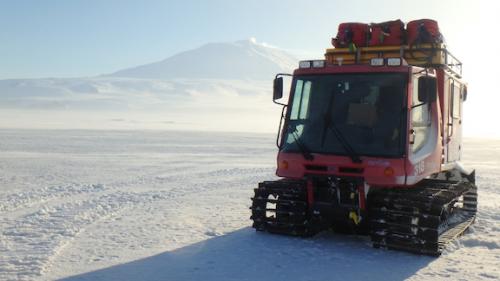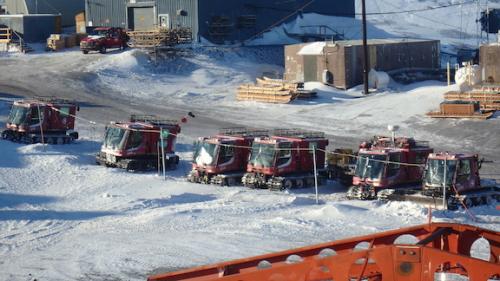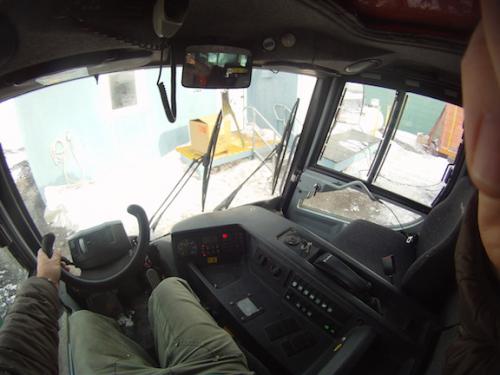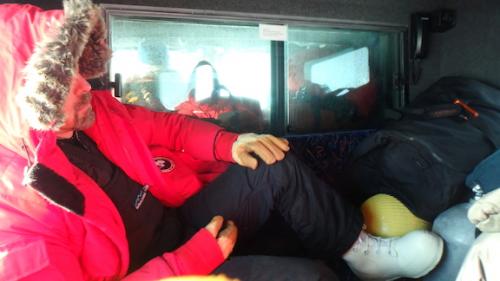 A PistenBully sits on the sea ice with the smoking summit of Mt. Erebus towering in the distance.
A PistenBully sits on the sea ice with the smoking summit of Mt. Erebus towering in the distance.
Team Pycno dives at a number of different predetermined locations offshore of Ross Island, and to reach our dive sites from McMurdo Station, we use a plucky and reliable tracked vehicle known as a "PistenBully" to ferry us across the ice. Rubber tracks give superb traction where tires might slip; all of the over-ice transports at McMurdo use some manner of mechanized track to venture out onto the frozen ocean. While tracks are a better option on ice and snow, they're not necessarily fast. Our PistenBully tops out at around 11mph/18kph, meaning a trip a few miles up the coast can take all day.
 McMurdo Station maintains a number of PistenBullys to suit a variety of station needs.
McMurdo Station maintains a number of PistenBullys to suit a variety of station needs.
PistenBully is actually a corporation that builds vehicles for all manner of wintertime activities and they're equipment comes ready to handle whatever the Antarctic can throw at it. Back home, turning my car over in the temperate morning drizzle of western Washington State is typically a "turn-key" experience. Starting up our PistenBully model 100 is more involved, given the -40F/-40C night time temperatures. In fact, there's a 12 step process for checking fluid levels, looking for leaks and damage, and warming up the 197hp/145kw Mercedes-Benz OM 924 LA diesel engine, before we can get going. Much more than an SUV on tracks, PistenBullys have plug-in battery and engine block heaters to keep things from freezing up while parked. Out on the ice, they've got a separate heater apart from the engine to keep the various fluids from freezing up. To carry our Emergency Survival Bags and other ice safety essentials, they've got exterior racks. Supposedly, they even float, (though I am unwilling to test this assertion experimentally), and there are even escape hatches in the roof should calamity befall the expedition.
 The view from the driver's seat of a PistenBully model 100.
The view from the driver's seat of a PistenBully model 100.
Driving a PistenBully is a profoundly different experience than riding in one. The heated driver's cabin is laid out almost like an airplane cockpit. Large windows give excellent visibility across the endless white plains. The ride in the suspension-equipped driver's seat is pillow-soft and the seat itself is even heated, which is nice. The cabin is equipped with VHF radio, GPS, and a robust defrosting system for to keep every window clear. It's also conveniently separated from the complaints of the people riding in back. The rear passenger compartment is large enough to carry eight people, and, with some ingenious packing, we've been successful in fitting four people along with gear for five divers. It's a cramped, heat-less, and bumpy ride, but it's not a bad way to watch Antarctica roll by (provided all that gear isn't blocking the windows). Still, at the end of a long day of sea spider field science, it's nice to roll back into McMurdo Station lulled by the rumble of the diesel and rocked to sleep by the tracks turning underneath your feet.
 Dr. Art Woods takes the opportunity to spread out in the spacious interior of the PistenBully passenger compartment.
Dr. Art Woods takes the opportunity to spread out in the spacious interior of the PistenBully passenger compartment.

Comments